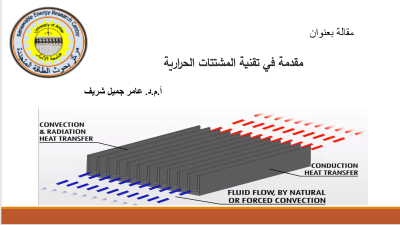| News Details |
Introduction to Heat Sink Technology
2022-04-28

Assist. Prof. Amer J. Sharif
The electronic component systems that arrange the processing, storing and transmission of data are the main part of the data centre, all of which create a large amount of heat, which must be removed from these components at a rate sufficient to avoid serious overheating problems and system failures. More than 30% of the heat removal cost of a typical data centre is used in IT equipment and cooling equipment. Thus, an important part of a server is the heat sink that is set over the CPU, as shown in Figure 1.
The thermal effect can cause the failure of mechanisms in electronic component devices, due to metal migration, void formation, and inter-metallic growth. Actually, one of the common factors that control the reliability of electronic products is the maximum temperature limitation of these devices. For each 10oC increase above the critical operating temperature (~85°C) of high-power electronics, the rate of these failures almost doubles. Therefore, electronics thermal management is of crucial significance, as is reflected in the market. Another important factor is the cost increase of thermal management products, which went from nearly $7.5 billion in 2010 to $8 billion in 2011, and is predicted to reach $10.9 billion by 2016; the annual rate of increase is 6.4%. Fans and heat sinks (HSs) as thermal management hardware components take an 84% share of the total market. However, software, interface materials, and substrates as the other main cooling products account for between 4% and 6% of the market.
Finned heat sinks are classified into two main types: plate fin heat sinks (PFHSs) and pin heat sinks or pinned heat sinks (PHSs), as shown in Figure 2. Such heat sinks are manufactured and produced by several companies, both large and small, such as Airedale in the UK and Raypak in the USA, to name of few. A set of base tube materials that have high thermal conductivity, such as copper and aluminium, can be employed to manufacture heat sinks depending on their cost and ease of manufacturing. In recent years, the technology relating to heat sinks designed for cooling electronics has become widespread and familiar, since their initial cost is low, they are simple to install, and have a reliable manufacturing process.
Fin morphology has an important function in manufacturing and heat transfer characteristics. Cylindrical, rectangular, square, elliptic, and conical or semi-conical are the widespread uniform pin fins geometries. In addition, pins offer a practical means of achieving a large heat transfer area without excessive primary surface area and act as turbulence promoters, thus further enhancing heat transfer rates by breaking up the thermal boundary layer for many applications, such as cooling electronic devices, including processes that use gas or liquid coolants. Therefore, it seems that it is a suitable time to employ this technology in traditional heat sinks and industrial applications as well.
In general, pin fin layouts are made up of a network of solid pins mounted directly on the heat sink surface. Either a staggered or an in-line arrangement is usually configured for arrays of pins with the working fluid flowing parallel or perpendicular to the pin axes.
 Reference:
Reference:
Amer Jameel Shareef. "Design Optimisation and Analysis of Heat Sinks for Electronics Cooling." PhD diss., University of Leeds, 2016









